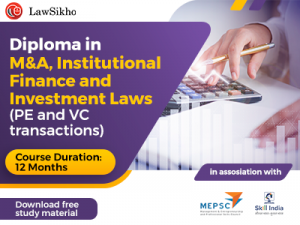This article has been written by Krati Agarwal, pursuing the Diploma Programme in M&A, Institutional Finance, and Investment Laws (PE and VC transactions) from LawSikho.
Table of Contents
Introduction
In any Merger & Acquisition transaction, there are a host of potentially significant risks underlying the deal. No one wants that after signing the dotted line they are faced with unexpected expensive surprises or roadblocks. That is why it is imperative to understand comprehensively, what are you getting into. Among other things, environmental factors will represent important risk and value components in M&A transactions. Therefore, M&A lawyers need to exclusively understand & address environmental risks in transactions as mitigating this risk and maximizing environmental-related synergies is an essential consideration before closing a deal. Also, companies should ensure that the existing environmental compliance framework is well integrated into their M&A strategy and execution. For example, environmental criteria consider how a company’s operations impact the natural environment, by considering its carbon footprint, its impact on biodiversity, waste production, and pollution, resource depletion, deforestation, etc. or for example permission to use groundwater resources may impose the duty on that company to conserve it as well, and hence trying to maintain the resources in long run. This in turn affects the investment, funding, and potential business partners’ relation with the company. 
Environmental due diligence
Environmental due diligence is treated as a mere formality to be conducted during the whole fact-checking process. It is not given the importance it should be. However, its benefits cannot be stressed enough. The main benefits for conducting environmental due diligence are:
- It points out environmental risks & liabilities which are due now or can be in the near future;
- It gives an opportunity to work on those risks & liabilities to formulate a negotiation stance;
- It can help in reducing cost from the buyer’s side;
- From the seller’s side, it makes them better prepared to present themselves to investors or acquirers after ticking all the boxes required;
- It helps in preparing strategies beforehand to manage the potential risks;
- It helps them decide the allocation of risk & liabilities post-deal.
It is pertinent to note that the acquiring party can simply ask for all the permits & compliance reports from the opposite side and a proper assessment of their legal liabilities arising out of these documents can be reported. But environmental due diligence in its proper form is more than this. There are specialized agencies set up to conduct environmental impact & due diligence with proper scientific metrics which lawyers aren’t equipped with. Some of these include topographic structure, rainfall patterns, seismic activities, biodiversity assessment, etc. There is no one fit for all scales in environmental due diligence, the needs are dependent on the sector the companies belong to. An IT-based company acquisition might have completely different requirements than a manufacturing unit takeover.
Role of lawyers in environmental due diligence
However, coming back to the role of lawyers in such situations, let us look at some of the laws we need to check properly before issuing an advisory.
|
S. No |
Act/ Rule/ Policy |
Objective |
Authority responsible |
Applicability |
|
1 |
Environmental Protection Act, 1986 If groundwater is needed, permission for the abstraction of groundwater required under the Act |
To protect the environment |
Ministry of Environment, Forest & Climate Change; State & Central Pollution Control Boards |
Applicable to almost all projects. |
|
2 |
Environmental Impact Assessment |
Required in developmental & expansion projects to study the impact of the activity on the environment |
Ministry of Environment, Forest & Climate Change; State & Central Pollution Control Boards |
Applicable to construction, developmental, real estate projects. |
|
3 |
Indian Forest Act, 1927; Forest (Conservation) Act, 1980; Forest (Conservation) Rules, 1981; National Forest policy |
Protection of forests and keeping track of deforestation activities and maintain ecological balance. A forest clearance certificate and tree felling license is required under these rules. |
Ministry of Environment, Forest & Climate Change; State Forest Department |
Applicable to projects linked to forests. Eg: laying a pipeline through a forest, dam construction, etc |
|
4 |
For the protection of National Parks & Sanctuaries for protection of flora & fauna |
National Board of Wildlife, Chief Wildlife Warden of State |
If the transaction is anyway related to Wildlife sanctuary, National Parks, etc. |
|
|
5 |
Conservation of biological diversity, promote equitable sharing of benefits |
Ministry of Environment, Forest & Climate Change; National Biodiversity Authority; State Biodiversity Board |
If the transaction somehow deals with biodiversities |
|
|
6 |
To control air pollution. Providing CTO (Consent to Operate) and CTE (Consent to Establish) certificates (NOC) |
Applicable to all factories, manufacturing units, expansion activity under the transaction deal |
||
|
7 |
To control Water Pollution. Providing CTO & CTE Certificates |
State Pollution Control Board |
Applicable to all factories, manufacturing units, expansion activity under the transaction deal |
|
|
8 |
For proper disposal of waste arising from construction & demolition of sites |
Local Authority & State Pollution Control Board |
Applicable to most of the transaction involving expansion & development |
|
|
9 |
For proper disposal of e-waste |
State Pollution Control Board |
Applicable to all major transaction, as e-waste is inevitable in every business activity |
|
|
10 |
Hazardous and Other Waste (Management and Trans-boundary Movement) Rules, 2016 |
Ensure safe handling, conversion, processing, and treatment of hazardous waste. Permission is required under these rules in case the company deals with hazardous substances. |
State Pollution Control Board |
Applicable to most of the transaction involving expansion & development |
|
11 |
To control noise levels |
State Pollution Control Board & Central Pollution Control Board |
Required at any manufacturing facility, production houses, etc |
|
|
12 |
Ozone Depleting Substances (Regulation & Control) Rules, 2000 |
Control & reduce the use of ozone-depleting substances |
Ministry of Environment, Forest & Climate Change |
Projects where air conditioning units play an important role |
*Apart from these laws, depending on the sector of the transaction, many other laws such as the Electricity Act, rules, energy conservation, Batteries Rules, etc. apply.
Next step
After getting all the clearances, documents & permits required and cross-checking them, a due diligence report is prepared depending on the performance of the company in terms of compliances. The report plays a very important part as it is an advisory that directly affects the transaction cost. There are few common mistakes to be avoided when it comes to preparing the due diligence report.
- Reliance on seller’s representation only: It is because the purpose of the transaction for both of them is different, the representations & warranties of the seller will be worded in their favor. It is always prudent to do your own fact-checking rather than solely relying on the seller’s representation & warranty.
- Time: It is because environmental due diligence is given little importance in big deals; it is usually done at the end. As a result, very few efforts are put into it. This should be avoided to have a safer transaction.
- Change in law: Environmental regulations are susceptible to a lot of changes. It is advised to check for all the recent regulations & requirements and not rely on an outdated source.
- Prepare your own checklist: Since the control of documents is in the hands of the seller, it is always advised to prepare a checklist of documents for referencing before starting the Due Diligence. This makes sure that you do not miss any important documents.
Allocation of risk after due diligence
The major purpose of conducting due diligence is to allocate risk in such a manner that the party’s liability is reduced. Depending on what side you represent, the following are certain measures that can be undertaken to reduce the liability.
- Condition precedent: The buyer can put environmental non-compliances as condition precedents in the contract. This will make sure that the seller gets rid of his liabilities in order to proceed with the transaction. This saves a lot of time and money post-transaction.
- Indemnity: Indemnity clauses are very common in M&A transactions. Here, one party promises to indemnify the other party, if stated events in the clause take place and the party suffers a loss due to it. The Buyer can take indemnity from the seller in case authority comes after them in the future for non-compliance of a past event; it is the responsibility of the seller to indemnify them. The seller can protect his interest in this case by imposing a proper procedure of notification to claim indemnity and adding a time limit of like 5 years within which he is liable to indemnify.
- Representations & warranties: These provisions come to the rescue of the buyer as the seller can be asked to represent & warrant that whatever he has stated is true and if things turn out the other way around, he will be the one bearing the cost of it.
- Confidentiality of due diligence: The whole due diligence process can be asked by the seller to be kept confidential. This is because it can harm the reputation of the seller if his/her company’s non-compliances or faults come to light. This is purely done to maintain the corporate image which can harm their business. The buyer can provide confidentiality in exchange for monetary value. This will benefit the buyer as it reduces his/her total cost in the M&A transaction.
- Maintaining escrow account for the environment: In many cases, especially in environmental concerns, the causes cannot be attributed to a particular party or a time frame as they can take place at a slower pace and build up before they show any visible signs. In such situations to divide the liabilities, the Buyer & Seller can agree to establish an escrow account for the environment. Both of them can fix the percentage of the money they have to put in it annually. This fund can be utilized in scenarios where it is difficult to pin down liability to one company or one-time frame.
Conclusion
Environmental due diligence is a long and tedious task. It takes a lot of effort, patience, and coordination. It is a deal-breaker and hence should be completed with utmost caution. environmental due diligence is not done in isolation. It involves specialized agencies working on-site & with lawyers working on the legal requirements of permits & licenses. If the on-site conditions give a green signal but the legal requirements are not complied with or when the company has all the legal compliances but physically the deal may affect the environment in an irreversible way, both these scenarios will cost the parties a lot of money and loss of business. Hence, coordination between the two teams is paramount for the success of the transaction. The advisory issued on the basis of the process can really help the parties in allocating the liabilities and bring down the overall cost of the transaction.
References
- https://www.consultivo.in/environment-energy/ehs-environmental-due-diligence/#1592905464771-d7f3a8f1-1c09
- https://www.mondaq.com/unitedstates/compliance/66176/environmental-due-diligence-in-mergers-acquisitions-ten-common-mistakes-to-avoid
- https://www.lexology.com/library/detail.aspx?g=2e48a51c-28be-45cd-b7f9-990bfc14fd21
- https://corporatefinanceinstitute.com/resources/knowledge/credit/environmental-due-diligence/
- https://www.integratesustainability.com.au/wp-content/uploads/2019/07/ISPL-Insight-Environmental-Due-Diligence.pdf
Students of Lawsikho courses regularly produce writing assignments and work on practical exercises as a part of their coursework and develop themselves in real-life practical skills.
LawSikho has created a telegram group for exchanging legal knowledge, referrals, and various opportunities. You can click on this link and join:
 Serato DJ Crack 2025Serato DJ PRO Crack
Serato DJ Crack 2025Serato DJ PRO Crack










 Allow notifications
Allow notifications



